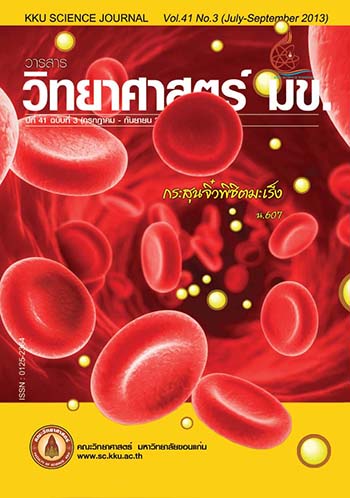The Studying Potassium Bromide Profile (KBr profile) of Drilledholes K-68 and K-70 in Nachueak District, Maha Sarakham Province to Prove the Overturn Bed of Rock Salt and Potash Bed in Maha Sarakham Formation by Comparative KBr Contents with a Normal Bed
Main Article Content
Abstract
The studying Potassium Bromide content as a profile (KBr profile) along the depth in each rock salt layer of Maha Sarakham Formation, Khorat Group of rock in northeastern Thailand can tell not only which is the layer of Upper, Middle or Lower Salt bed, but also tell about the overturn bed of the rock salt layer.
The author tries to do the research by using some drilled-holes samples from Department of Mineral Resources who drilled in the Potash and Rock Salt Project in the northeastern part of Thailand. There are 2 holes, K-68 and K-70, at Nachueak District, Maha Sarakham Province, found that the sequences of the stratigraphy are so different from others. The author tries to use the KBr profile in rock salt layers in the holes K-68 and K-70 comparing to other normal sequence in other holes.
The result is found that in the drilled-hole K-68, the rock salt layer overlaying the “potash zone” bed (sylvite and carnallite) is the upper sequence of “lower salt” bed instead of the lower salt should be under the potash zone. This is because the KBr profile is so higher than other salt layers and it is the interval contact the potash layer. The beyond layer is thin “color salt” bed that has the KBr profile like other holes but in the reversed direction. The next lower layer is reddish brown clay of “lower clastic” that cannot use the KBr profile. Then the hole is drilled through the “middle salt” layer which normally it should be over the lower salt. This layer by the KBr profile, is found the overturn fold clearly because the KBr content is always high at 200 ppm This is the “lower sequence” of the “middle salt”. Then it is down through the “lower clastic” again before the drilling activity is abandon. For the drilled holes K-70, the first drilled layer is the “lower salt” because the KBr content is so high at 400-500 ppm which mean that the layer is near the contact with potash layer, but the shape of the profile is reverse direction comparing to normal drilled holes. Then, it is drilled through the “potash zone” that is all carnallite before going through the “color salt” layer. The KBr profile in the “color salt” layer is like the KBr-68 that is reversed side. The drilling was stopped in the “lower clastic” layer.
The characteristics of these rock layers indicate that the bedding of these 2 drilled holes
is sequential layer as an “overturn bed” certainly.
Article Details

This work is licensed under a Creative Commons Attribution-NonCommercial-NoDerivatives 4.0 International License.


